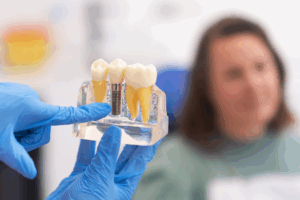
Dental implants are one of the most reliable and long-lasting solutions around for replacing missing teeth, designed to look, feel, and function just like your natural pearly whites. Better yet, when properly cared for, they have the potential to last for decades or even a lifetime. However, occasionally, a patient may notice that their dental implant feels loose. While uncommon, it’s very important not to ignore this, as a loose implant may indicate an underlying issue that requires attention! Here’s what you need to know.
How Do Dental Implants Become Loose?
There is no one specific reason for dental implant failure; it can occur due to a variety of circumstances. In many cases, the implant post, which is the part that’s placed directly into your jawbone, is still secure; however, what’s actually loose is the restoration portion that’s placed on top, or the abutment, which is the connector piece between the two. This looseness can occur due to a variety of reasons, but it often occurs due to excessive bite pressure or teeth grinding.
For an implant to stay stable, it must also be firmly anchored and healthy jawbone tissue. If gum disease causes the surrounding bone to deteriorate, the implant can lose its support and begin to move slightly. If gum disease is allowed to progress, peri-implantitis can form, which is an infection that damages the tissue stabilizing the implant and leads to failure. This is why oral hygiene is so crucial once you receive dental implants—failing to brush and floss consistently and skipping routine checkups will jeopardize your new smile!
Your First Steps If Your Dental Implant Feels Loose
If your implant feels loose, you shouldn’t hesitate to contact your dentist right away, even if you aren’t experiencing any pain! Also, avoid wiggling or biting on the area of your mouth, and don’t try to tighten or adjust anything yourself.
During your appointment, your dentist will examine the implant and surrounding gum tissue, take X-rays and other diagnostics to check for bone loss or infection, and ultimately determine whether the problem is with the restoration portion, abutment, or the implant post itself.
From there, they’ll recommend a course of action that may involve a small readjustment, replacing a component, treating an infection, or assisting damaged bone or gum tissue. In all cases, prompt evaluation is key—the problem will not resolve on its own!
You can greatly reduce the risk of implant complications by taking care of business at home with your toothbrush; however, it’s just as important to be aware of the potential signs of dental implant failure. If something feels loose or off, don’t hesitate to contact your dentist for assistance.
About the Author
Dr. J. Darrell Steele attended dental school at Baylor College of Dentistry and is a proud member of numerous professional organizations, including the American Association of Oral and Maxillofacial Surgeons and the Texas Society of Oral and Maxillofacial Surgeons. His practice in Coppell offers a wide range of services, including dental implants placed in-house by Dr. Steele himself. If you have any questions about the blog or you’d like to get in touch with our office to schedule an appointment, please reach out online or call today for more information. Telephone: (972) 315-3355.






